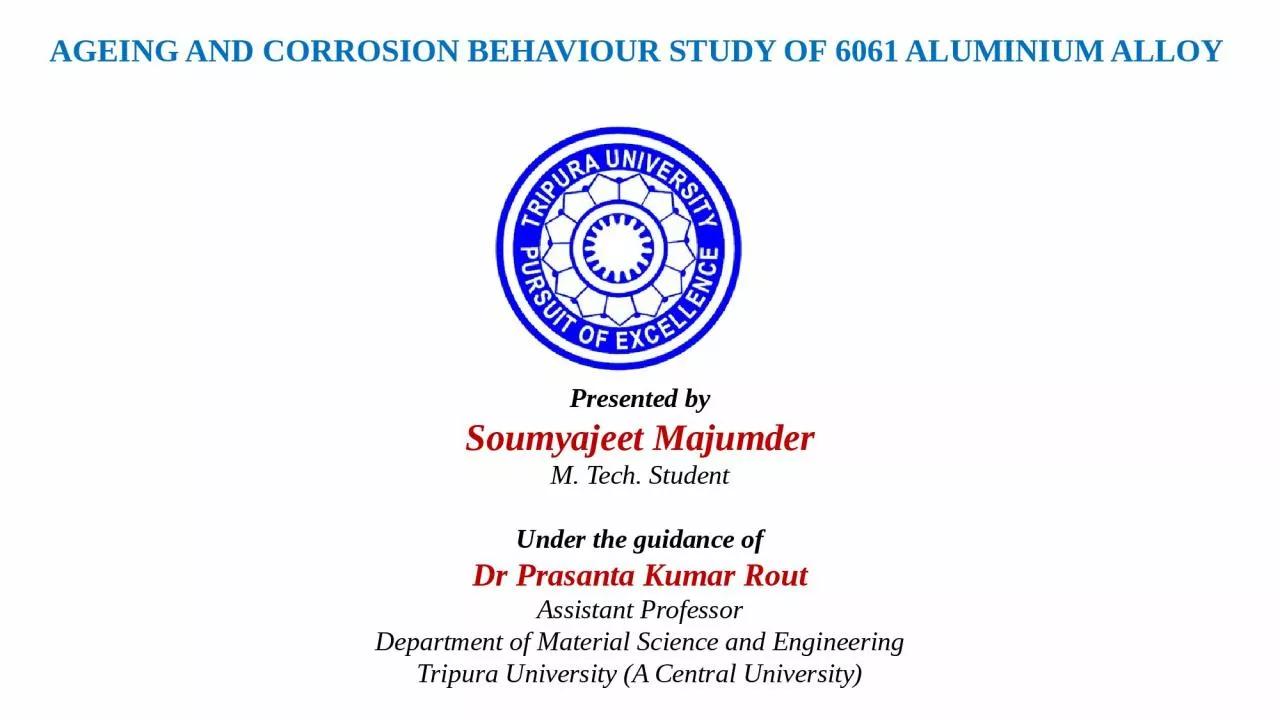

Presented by Soumyajeet Majumder M Tech Student Under the guidance of Dr Prasanta Kumar Rout Assistant Professor Department of Material Science and Engineering Tripura University A Central University ID: 1034455
Download Presentation The PPT/PDF document "AGEING AND CORROSION BEHAVIOUR STUDY OF ..." is the property of its rightful owner. Permission is granted to download and print the materials on this web site for personal, non-commercial use only, and to display it on your personal computer provided you do not modify the materials and that you retain all copyright notices contained in the materials. By downloading content from our website, you accept the terms of this agreement.
1. AGEING AND CORROSION BEHAVIOUR STUDY OF 6061 ALUMINIUM ALLOY Presented bySoumyajeet MajumderM. Tech. StudentUnder the guidance ofDr Prasanta Kumar RoutAssistant ProfessorDepartment of Material Science and EngineeringTripura University (A Central University)
2. IntroductionFor over fifty years aluminum ranks at second to iron and steel in the metal market. The demand of aluminum has grown rapidly because it is attributed to a unique combination of properties which makes it become the most versatile of engineering and construction material of present time.It has been widely used in aerospace, ships, railway vehicles, automobiles and related fields.6061 Aluminum Alloy is a heat treatable strengthening alloy of 6XXX series that posses medium strength and good weldability and machinability.The major components in AA 6061 consists of Magnesium and Silicon while Iron, Copper, Chromium, Zinc, Titanium and Manganese are present relatively in minor proportions.Besides it has good electrical and thermal conductivities and high reflectivity to both heat and light. It is non-toxic and highly corrosion resistant under any service conditions.Precipitation hardening is a process that enhances the strength and hardness of metal alloys by the formation of extremely small uniformly dispersed particle of a second phase within the original phase matrix. AH 1 Cobra rotor blades AR 15 rifle components Bicycle Frames Yachts
3. Experimental ProcedureMaterial:An alloy plate in the 6061 was used as the test material and the chemical composition of the aluminum alloy is tabulated below.Microstructure Study:The plate was cut into the samples of 10 mm*10 mm*3 mm and the sample were grinded using SiC emery papers from 100 grit to 2000 grit and polished on disc polishing machine and then etched using Keller's reagent and subsequently washed and rinsed with acetone.Then the samples were observed with Optical Microscope (Leica DM 750). Ageing and Hardness Study:The samples were grinded using SiC emery papers from 100 grit to 600 grit before the heat treatment procedure.The samples were solution treated at 530°C for 2 hours and then quenched to room temperature in ice water followed artificial aging at 180°C up to 25 hours.Rockwell Hardness Test (RHB) has been carried out on the same artificially aged samples using 1.588mm Tungsten ball indenter and 100kgf load.Electrochemical Study:Before electrochemical study the samples were grinded using SiC emery papers from 100 grit to 2000 grit and polished on disc polishing machine (Chennai Metco) using 1 micron diamond paste to analyze the same samples for corrosion Open Circuit Potential (OCP) with time measurements of the samples were taken via electrochemical workstation (CH Instruments 660 E) using a three-electrode system using 3.5wt% NaCl solution as electrolyte for 1 hour. The heat treated alloy was used as the working electrode, Ag/ AgCl as reference electrode and a platinum(Pt) as counter electrode.In order to investigate the effect of corrosion the microstructures of the samples were observed under optical microscope.Al Mg SiFeCu CrZnTiMn96.001.200.800.700.400.350.250.150.15
4. Results and DiscussionsMicrostructure Analysis:The microstructure reveals many second phase intermetallic particles. (Ref 1)The sizes of these second-phase intermetallic particles are found to be in the range of 10-15 microns.Ageing and Hardness Analysis: Ageing curve shows the variation of hardness of the alloy during artificially aging at 180°C for varying time, displayed the characteristic age-hardening behavior, i.e., a sharp and progressive increase of hardness with the increasing aging time, reaching to a maximum value (peak aged) and then a decrease of hardness with the increasing aging time leading to over-aged state. (Ref 2)The highest hardness (RHB) value of 69.3 is achieved at 12 hours of aging time.Microstructure of as received AA 6061
5. Results and Discussions (Continued…)OCP with time graphs shows similar trend for all the alloy tempers in 3.5% NaCl solution.Further, it has been seen from the graph that with ageing time the OCP value shift towards positive or noble side. (Ref 3)Optical micrographs pictures of OCP tested samples reveals various sizes of pitting attack.Electrochemical Analysis:AS Quenched (AQ)Under Age (UA)Peak Age (PA)Over Age (OA)
6. ConclusionThe study shows the variation of hardness of the AA 6061 during artificial aging exhibited due to precipitation hardening phenomena.The micrographs of as quenched, under aged, peak aged and over aged tempers exhibits corrosion pits when treated using 3.5wt% NaCl solution for 1 hour.ReferencesC. F. Tan and R. Mohd. Said, Effect of Hardness Test on Precipitation Hardening Aluminum Alloy 6061-T6, Journal of Science, 2008, pp. 276-286.Adem Ona, Effects of artificial aging heat treatment on mechanical properties and corrosion behavior of AA6XXX aluminum alloys, Journal of Chemical Engineering and Materials Science, 2018, pp. 17-23.M. Zhu, B.Z. Zhao, Y.F. Yuan, S.Y. Guo, and J. Pan, Effect of Solution Temperature on the Corrosion Behavior of 6061-T6 Aluminum Alloy in NaCl Solution, ASM International, Journal of Materials Engineering and Performance, 2020, pp. 4725–4732.